Trompenaars & Hampden-Turner Dimensions Model of Culture
VerifiedAdded on 2022/11/10
|14
|1368
|326
Presentation
AI Summary
This presentation discusses the Trompenaars & Hampden-Turner Dimensions Model of Culture and its relevance in cross-cultural management. It also covers other models such as Hofstede's Model of Culture, cultural diversity, cultural dilemma, and criticism of Trompenaars's theory. The presentation concludes with the importance of understanding culture for successful global business management.
Contribute Materials
Your contribution can guide someone’s learning journey. Share your
documents today.
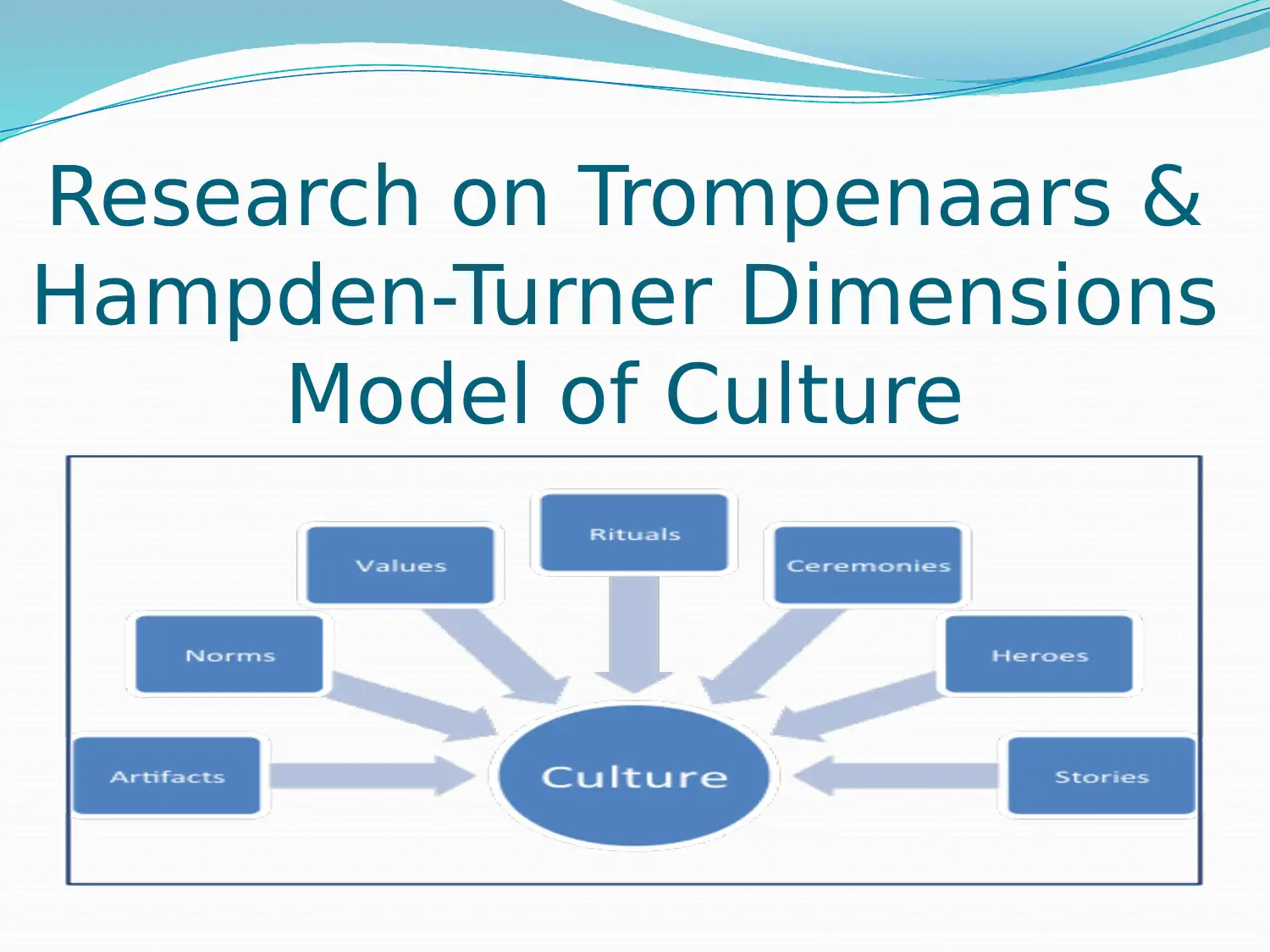
Research on Trompenaars &
Hampden-Turner Dimensions
Model of Culture
Hampden-Turner Dimensions
Model of Culture
Secure Best Marks with AI Grader
Need help grading? Try our AI Grader for instant feedback on your assignments.
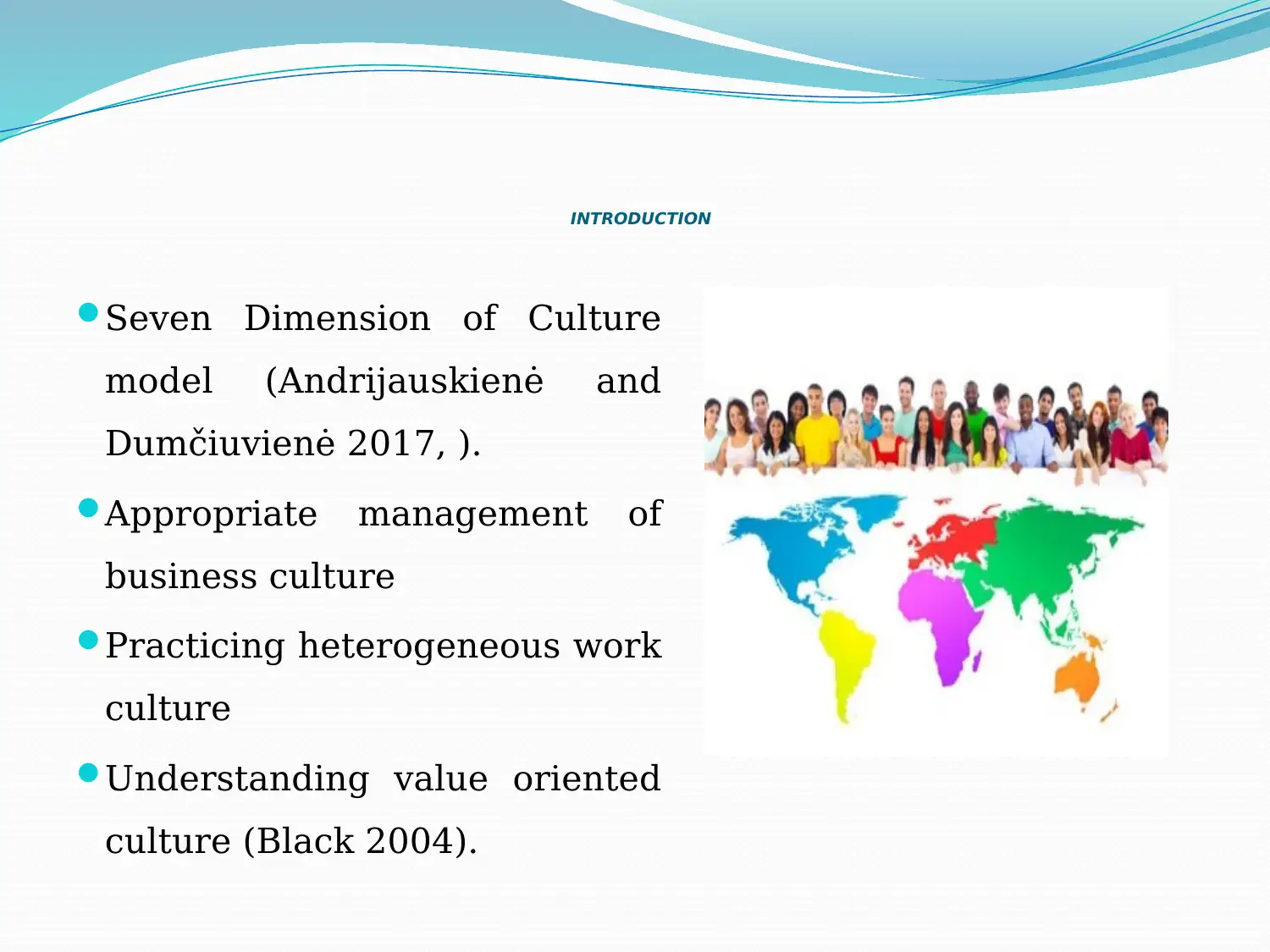
INTRODUCTION
Seven Dimension of Culture
model (Andrijauskienė and
Dumčiuvienė 2017, ).
Appropriate management of
business culture
Practicing heterogeneous work
culture
Understanding value oriented
culture (Black 2004).
Seven Dimension of Culture
model (Andrijauskienė and
Dumčiuvienė 2017, ).
Appropriate management of
business culture
Practicing heterogeneous work
culture
Understanding value oriented
culture (Black 2004).
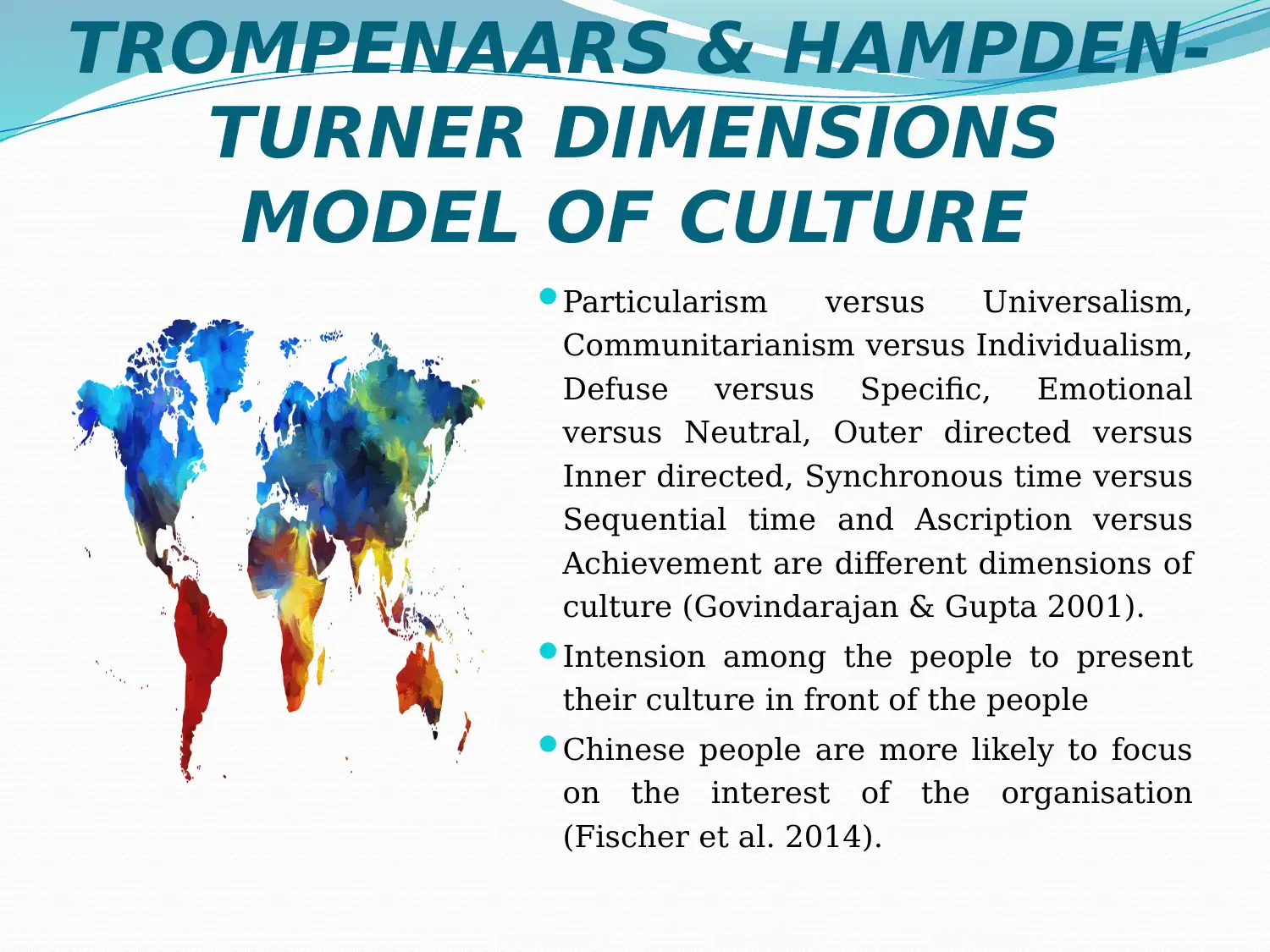
TROMPENAARS & HAMPDEN-
TURNER DIMENSIONS
MODEL OF CULTURE
Particularism versus Universalism,
Communitarianism versus Individualism,
Defuse versus Specific, Emotional
versus Neutral, Outer directed versus
Inner directed, Synchronous time versus
Sequential time and Ascription versus
Achievement are different dimensions of
culture (Govindarajan & Gupta 2001).
Intension among the people to present
their culture in front of the people
Chinese people are more likely to focus
on the interest of the organisation
(Fischer et al. 2014).
TURNER DIMENSIONS
MODEL OF CULTURE
Particularism versus Universalism,
Communitarianism versus Individualism,
Defuse versus Specific, Emotional
versus Neutral, Outer directed versus
Inner directed, Synchronous time versus
Sequential time and Ascription versus
Achievement are different dimensions of
culture (Govindarajan & Gupta 2001).
Intension among the people to present
their culture in front of the people
Chinese people are more likely to focus
on the interest of the organisation
(Fischer et al. 2014).
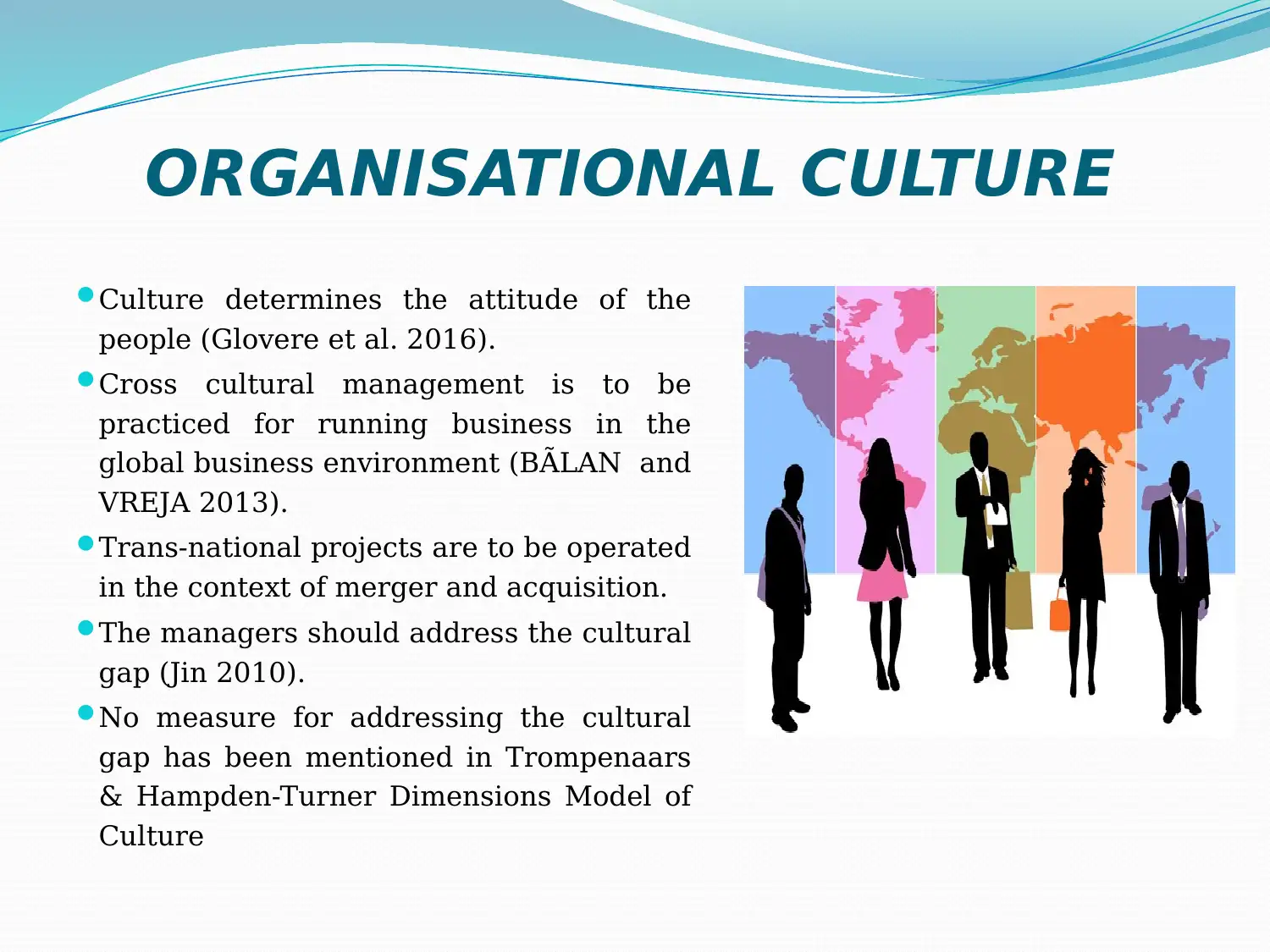
ORGANISATIONAL CULTURE
Culture determines the attitude of the
people (Glovere et al. 2016).
Cross cultural management is to be
practiced for running business in the
global business environment (BÃLAN and
VREJA 2013).
Trans-national projects are to be operated
in the context of merger and acquisition.
The managers should address the cultural
gap (Jin 2010).
No measure for addressing the cultural
gap has been mentioned in Trompenaars
& Hampden-Turner Dimensions Model of
Culture
Culture determines the attitude of the
people (Glovere et al. 2016).
Cross cultural management is to be
practiced for running business in the
global business environment (BÃLAN and
VREJA 2013).
Trans-national projects are to be operated
in the context of merger and acquisition.
The managers should address the cultural
gap (Jin 2010).
No measure for addressing the cultural
gap has been mentioned in Trompenaars
& Hampden-Turner Dimensions Model of
Culture
Secure Best Marks with AI Grader
Need help grading? Try our AI Grader for instant feedback on your assignments.
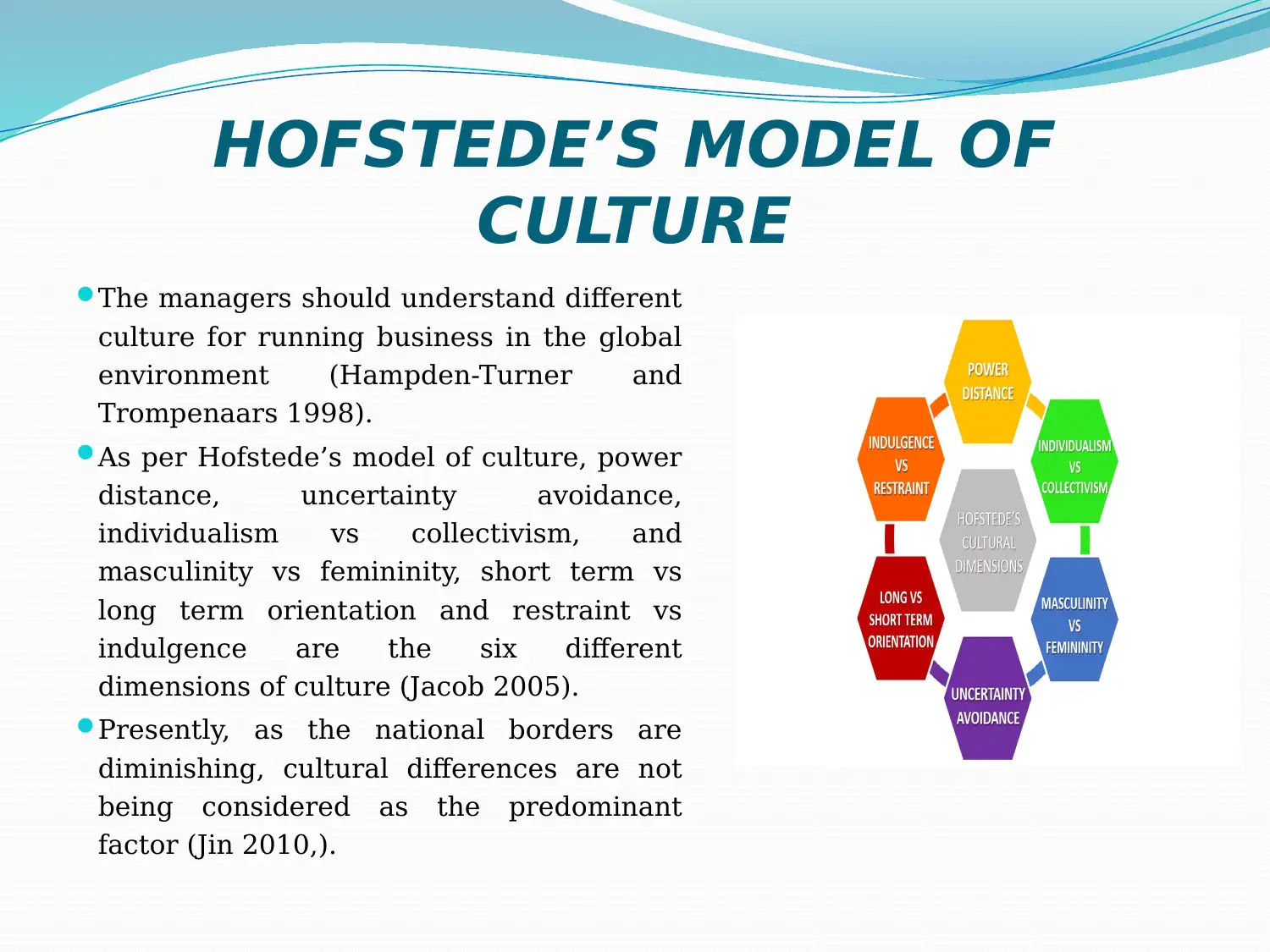
HOFSTEDE’S MODEL OF
CULTURE
The managers should understand different
culture for running business in the global
environment (Hampden-Turner and
Trompenaars 1998).
As per Hofstede’s model of culture, power
distance, uncertainty avoidance,
individualism vs collectivism, and
masculinity vs femininity, short term vs
long term orientation and restraint vs
indulgence are the six different
dimensions of culture (Jacob 2005).
Presently, as the national borders are
diminishing, cultural differences are not
being considered as the predominant
factor (Jin 2010,).
CULTURE
The managers should understand different
culture for running business in the global
environment (Hampden-Turner and
Trompenaars 1998).
As per Hofstede’s model of culture, power
distance, uncertainty avoidance,
individualism vs collectivism, and
masculinity vs femininity, short term vs
long term orientation and restraint vs
indulgence are the six different
dimensions of culture (Jacob 2005).
Presently, as the national borders are
diminishing, cultural differences are not
being considered as the predominant
factor (Jin 2010,).
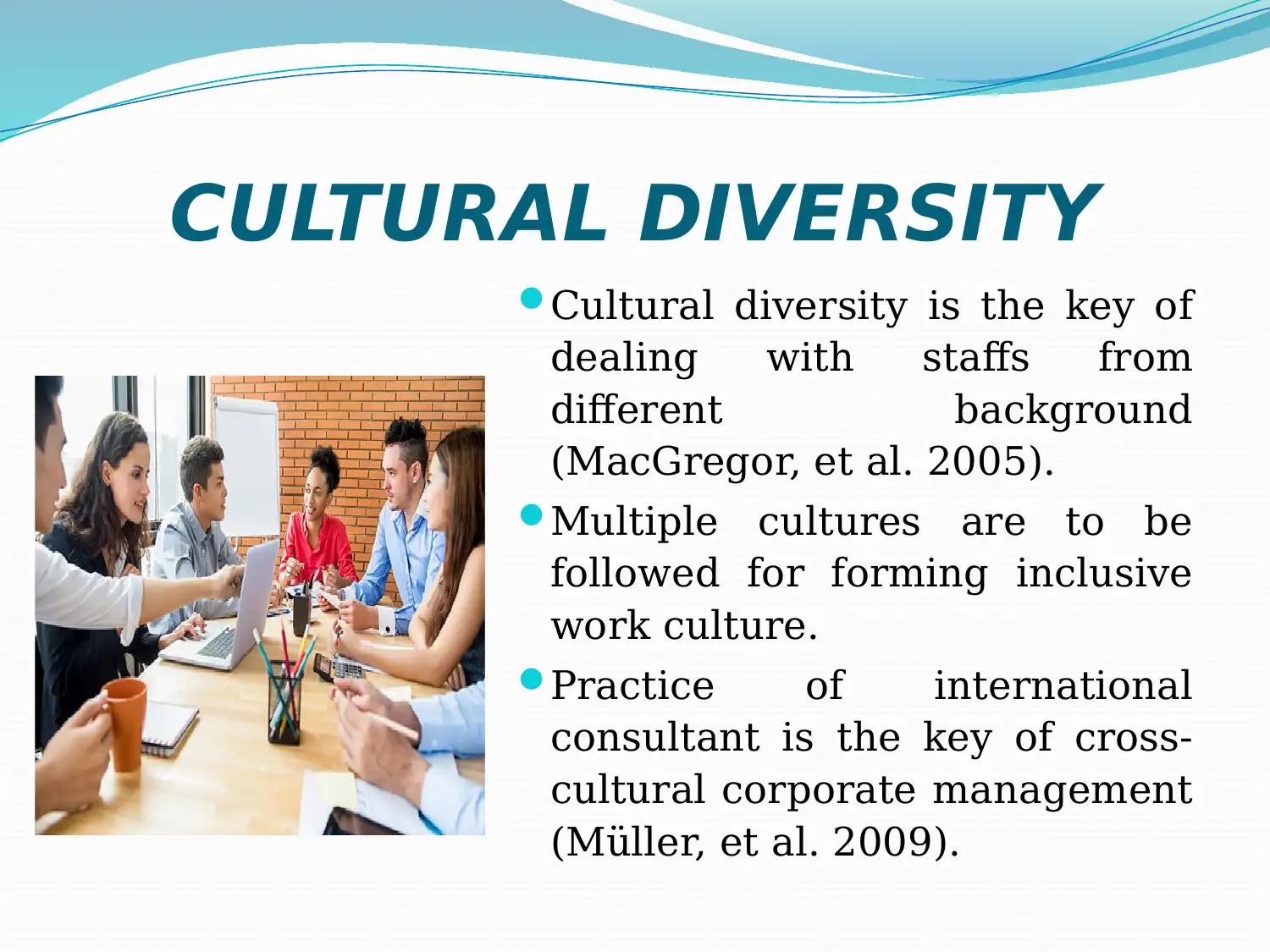
CULTURAL DIVERSITY
Cultural diversity is the key of
dealing with staffs from
different background
(MacGregor, et al. 2005).
Multiple cultures are to be
followed for forming inclusive
work culture.
Practice of international
consultant is the key of cross-
cultural corporate management
(Müller, et al. 2009).
Cultural diversity is the key of
dealing with staffs from
different background
(MacGregor, et al. 2005).
Multiple cultures are to be
followed for forming inclusive
work culture.
Practice of international
consultant is the key of cross-
cultural corporate management
(Müller, et al. 2009).
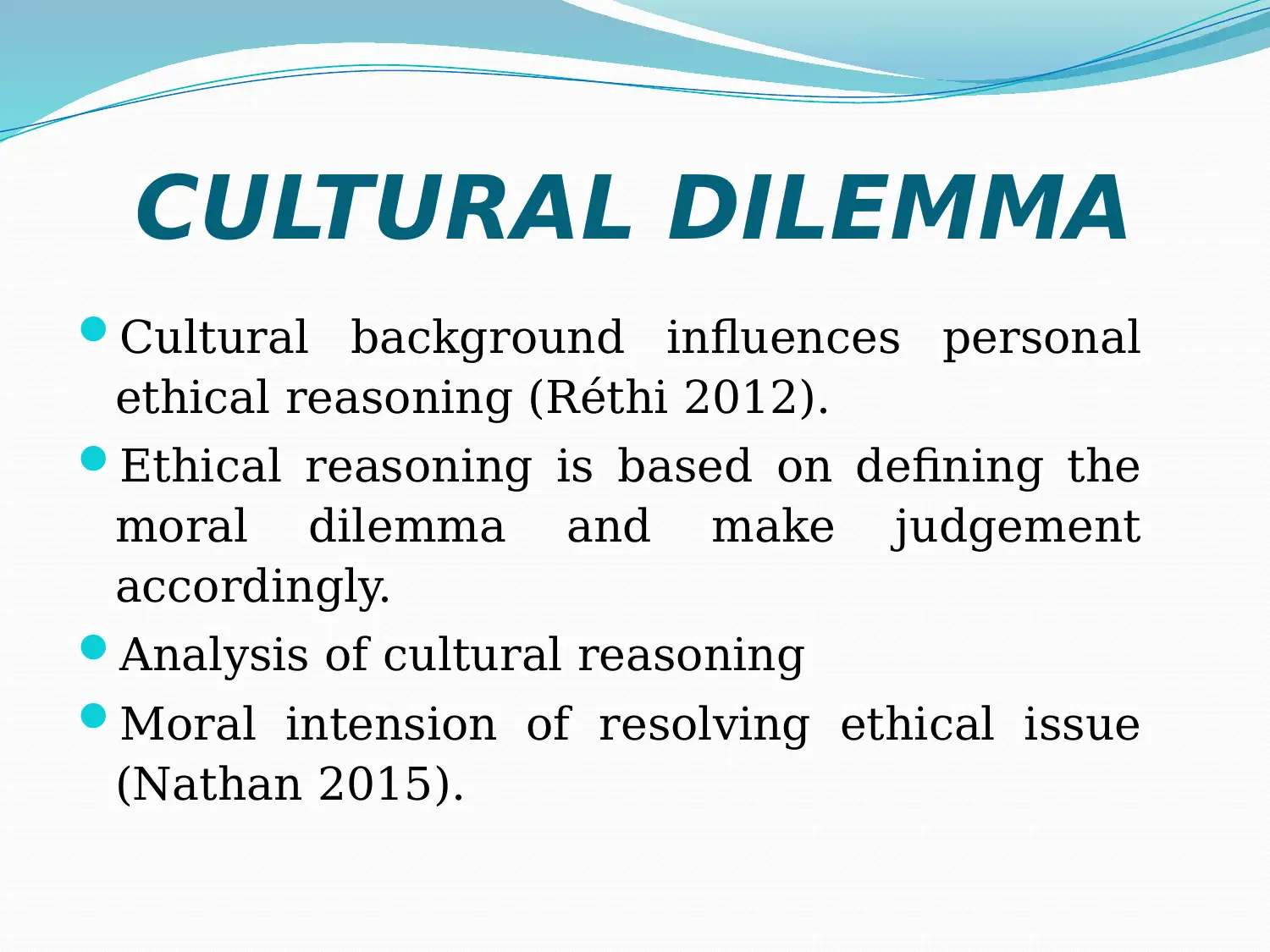
CULTURAL DILEMMA
Cultural background influences personal
ethical reasoning (Réthi 2012).
Ethical reasoning is based on defining the
moral dilemma and make judgement
accordingly.
Analysis of cultural reasoning
Moral intension of resolving ethical issue
(Nathan 2015).
Cultural background influences personal
ethical reasoning (Réthi 2012).
Ethical reasoning is based on defining the
moral dilemma and make judgement
accordingly.
Analysis of cultural reasoning
Moral intension of resolving ethical issue
(Nathan 2015).
Paraphrase This Document
Need a fresh take? Get an instant paraphrase of this document with our AI Paraphraser
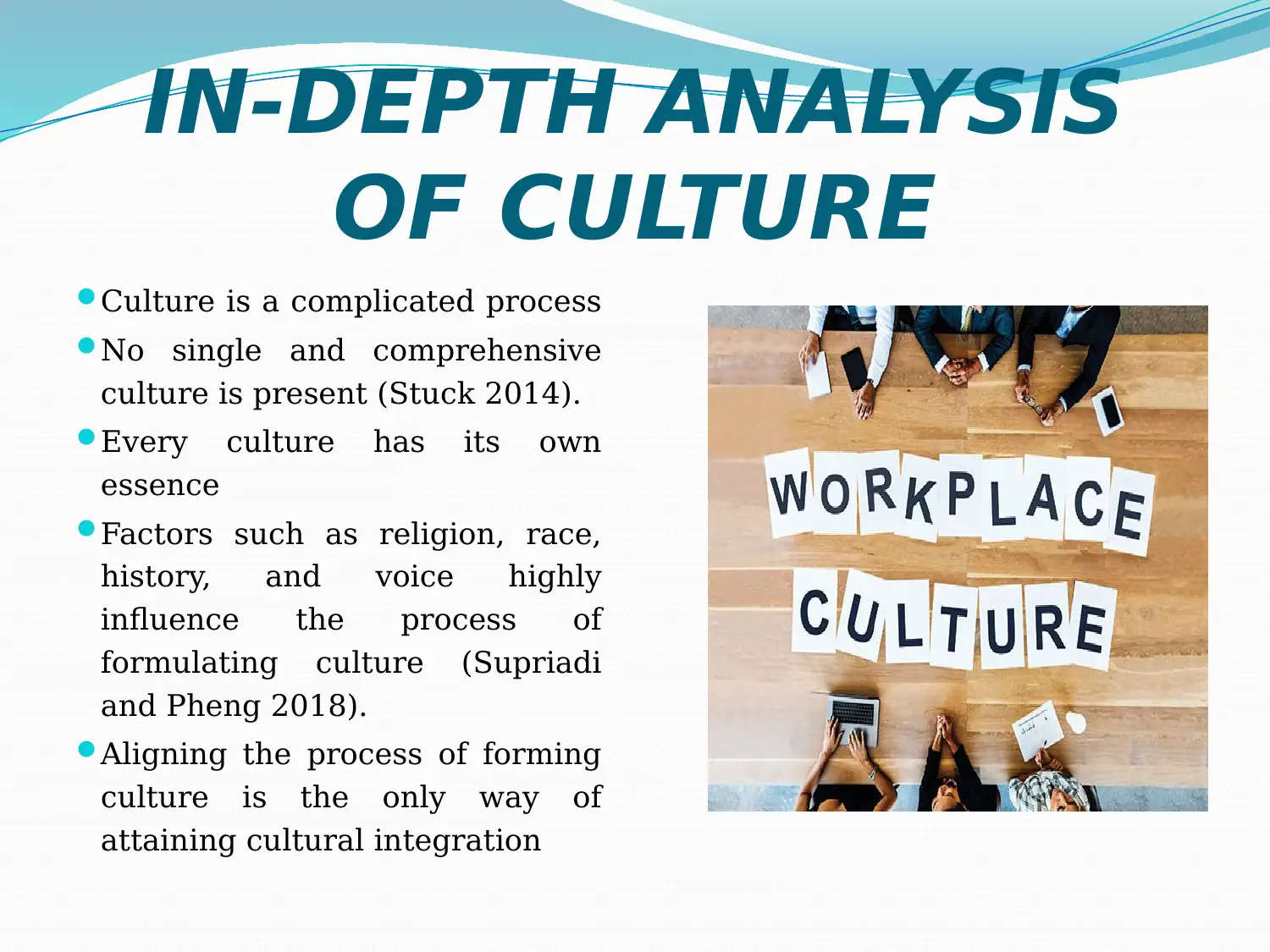
IN-DEPTH ANALYSIS
OF CULTURE
Culture is a complicated process
No single and comprehensive
culture is present (Stuck 2014).
Every culture has its own
essence
Factors such as religion, race,
history, and voice highly
influence the process of
formulating culture (Supriadi
and Pheng 2018).
Aligning the process of forming
culture is the only way of
attaining cultural integration
OF CULTURE
Culture is a complicated process
No single and comprehensive
culture is present (Stuck 2014).
Every culture has its own
essence
Factors such as religion, race,
history, and voice highly
influence the process of
formulating culture (Supriadi
and Pheng 2018).
Aligning the process of forming
culture is the only way of
attaining cultural integration
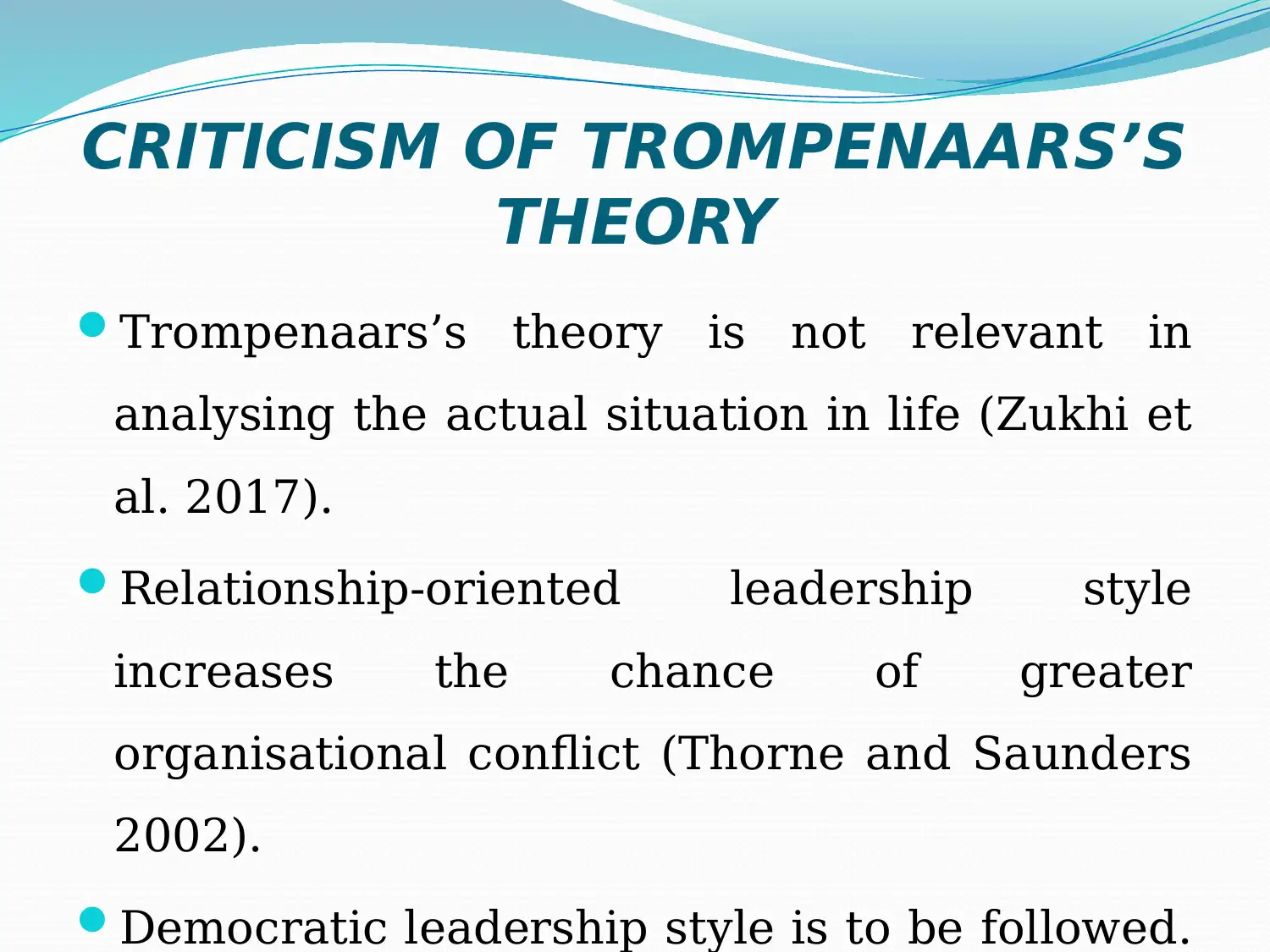
CRITICISM OF TROMPENAARS’S
THEORY
Trompenaars’s theory is not relevant in
analysing the actual situation in life (Zukhi et
al. 2017).
Relationship-oriented leadership style
increases the chance of greater
organisational conflict (Thorne and Saunders
2002).
Democratic leadership style is to be followed.
THEORY
Trompenaars’s theory is not relevant in
analysing the actual situation in life (Zukhi et
al. 2017).
Relationship-oriented leadership style
increases the chance of greater
organisational conflict (Thorne and Saunders
2002).
Democratic leadership style is to be followed.

CROSS CULTURAL
MANAGEMENT
Cross cultural management is
the key factor of international
business (Trompenaars and
Woolliams 2002).
Strengthening the business
interaction in between
different countries
Mangers have to follow
different approaches to
mitigate the prevalent culture
related issues (Yerznkyan
2016).
MANAGEMENT
Cross cultural management is
the key factor of international
business (Trompenaars and
Woolliams 2002).
Strengthening the business
interaction in between
different countries
Mangers have to follow
different approaches to
mitigate the prevalent culture
related issues (Yerznkyan
2016).
Secure Best Marks with AI Grader
Need help grading? Try our AI Grader for instant feedback on your assignments.
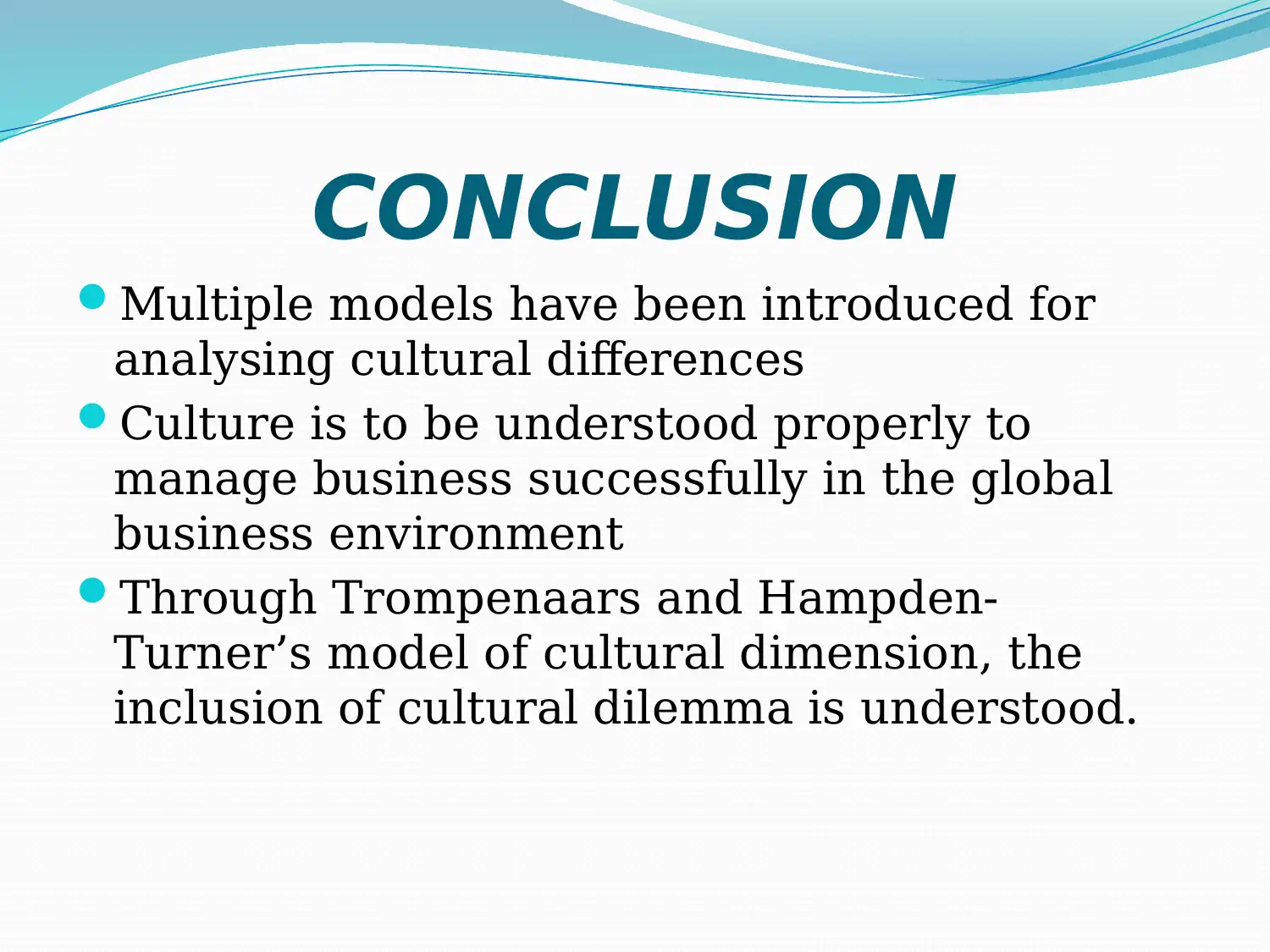
CONCLUSION
Multiple models have been introduced for
analysing cultural differences
Culture is to be understood properly to
manage business successfully in the global
business environment
Through Trompenaars and Hampden-
Turner’s model of cultural dimension, the
inclusion of cultural dilemma is understood.
Multiple models have been introduced for
analysing cultural differences
Culture is to be understood properly to
manage business successfully in the global
business environment
Through Trompenaars and Hampden-
Turner’s model of cultural dimension, the
inclusion of cultural dilemma is understood.
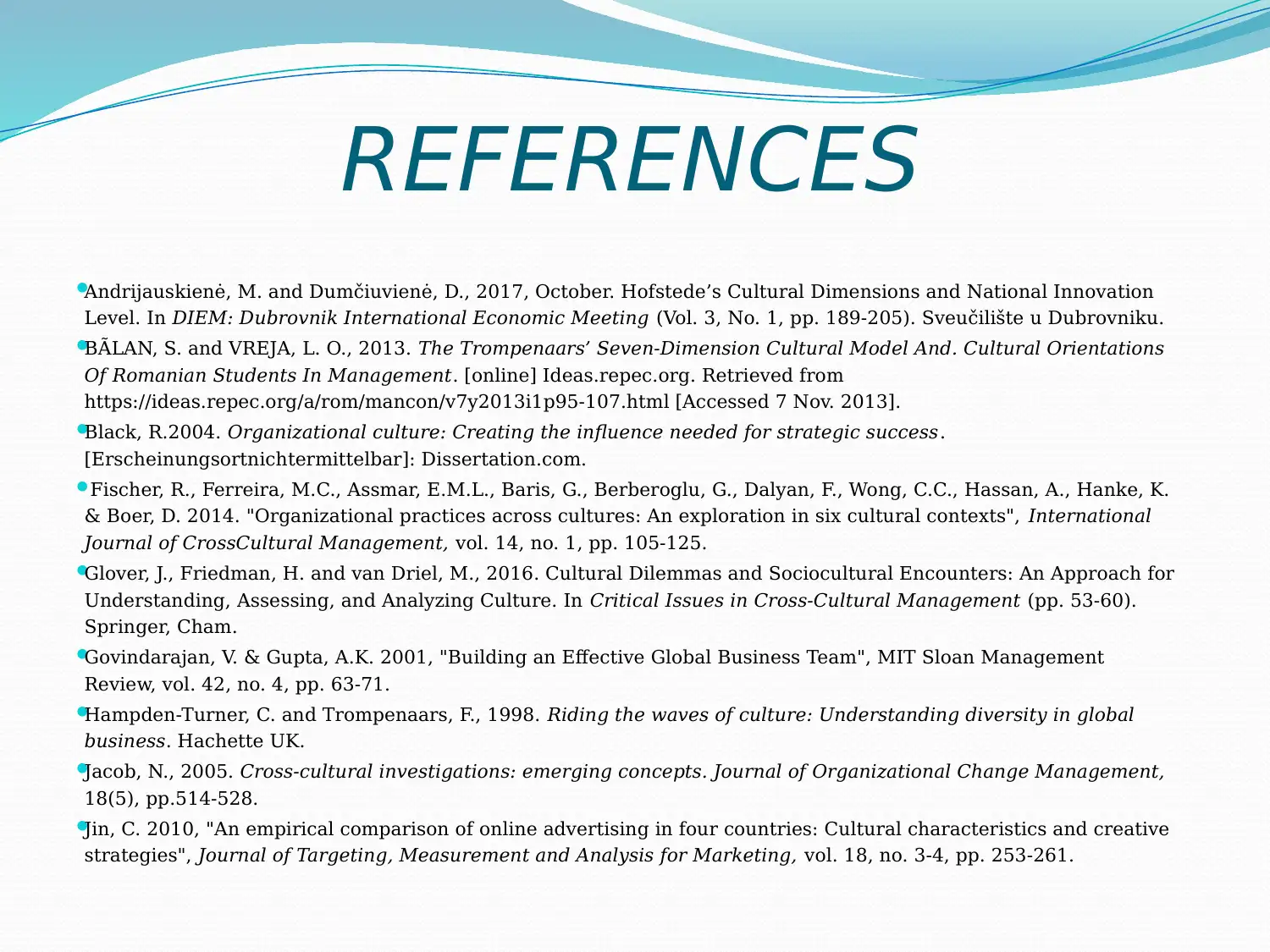
REFERENCES
Andrijauskienė, M. and Dumčiuvienė, D., 2017, October. Hofstede’s Cultural Dimensions and National Innovation
Level. In DIEM: Dubrovnik International Economic Meeting (Vol. 3, No. 1, pp. 189-205). Sveučilište u Dubrovniku.
BÃLAN, S. and VREJA, L. O., 2013. The Trompenaars’ Seven-Dimension Cultural Model And. Cultural Orientations
Of Romanian Students In Management. [online] Ideas.repec.org. Retrieved from
https://ideas.repec.org/a/rom/mancon/v7y2013i1p95-107.html [Accessed 7 Nov. 2013].
Black, R.2004. Organizational culture: Creating the influence needed for strategic success.
[Erscheinungsortnichtermittelbar]: Dissertation.com.
Fischer, R., Ferreira, M.C., Assmar, E.M.L., Baris, G., Berberoglu, G., Dalyan, F., Wong, C.C., Hassan, A., Hanke, K.
& Boer, D. 2014. "Organizational practices across cultures: An exploration in six cultural contexts", International
Journal of CrossCultural Management, vol. 14, no. 1, pp. 105-125.
Glover, J., Friedman, H. and van Driel, M., 2016. Cultural Dilemmas and Sociocultural Encounters: An Approach for
Understanding, Assessing, and Analyzing Culture. In Critical Issues in Cross-Cultural Management (pp. 53-60).
Springer, Cham.
Govindarajan, V. & Gupta, A.K. 2001, "Building an Effective Global Business Team", MIT Sloan Management
Review, vol. 42, no. 4, pp. 63-71.
Hampden-Turner, C. and Trompenaars, F., 1998. Riding the waves of culture: Understanding diversity in global
business. Hachette UK.
Jacob, N., 2005. Cross‐cultural investigations: emerging concepts. Journal of Organizational Change Management,
18(5), pp.514-528.
Jin, C. 2010, "An empirical comparison of online advertising in four countries: Cultural characteristics and creative
strategies", Journal of Targeting, Measurement and Analysis for Marketing, vol. 18, no. 3-4, pp. 253-261.
Andrijauskienė, M. and Dumčiuvienė, D., 2017, October. Hofstede’s Cultural Dimensions and National Innovation
Level. In DIEM: Dubrovnik International Economic Meeting (Vol. 3, No. 1, pp. 189-205). Sveučilište u Dubrovniku.
BÃLAN, S. and VREJA, L. O., 2013. The Trompenaars’ Seven-Dimension Cultural Model And. Cultural Orientations
Of Romanian Students In Management. [online] Ideas.repec.org. Retrieved from
https://ideas.repec.org/a/rom/mancon/v7y2013i1p95-107.html [Accessed 7 Nov. 2013].
Black, R.2004. Organizational culture: Creating the influence needed for strategic success.
[Erscheinungsortnichtermittelbar]: Dissertation.com.
Fischer, R., Ferreira, M.C., Assmar, E.M.L., Baris, G., Berberoglu, G., Dalyan, F., Wong, C.C., Hassan, A., Hanke, K.
& Boer, D. 2014. "Organizational practices across cultures: An exploration in six cultural contexts", International
Journal of CrossCultural Management, vol. 14, no. 1, pp. 105-125.
Glover, J., Friedman, H. and van Driel, M., 2016. Cultural Dilemmas and Sociocultural Encounters: An Approach for
Understanding, Assessing, and Analyzing Culture. In Critical Issues in Cross-Cultural Management (pp. 53-60).
Springer, Cham.
Govindarajan, V. & Gupta, A.K. 2001, "Building an Effective Global Business Team", MIT Sloan Management
Review, vol. 42, no. 4, pp. 63-71.
Hampden-Turner, C. and Trompenaars, F., 1998. Riding the waves of culture: Understanding diversity in global
business. Hachette UK.
Jacob, N., 2005. Cross‐cultural investigations: emerging concepts. Journal of Organizational Change Management,
18(5), pp.514-528.
Jin, C. 2010, "An empirical comparison of online advertising in four countries: Cultural characteristics and creative
strategies", Journal of Targeting, Measurement and Analysis for Marketing, vol. 18, no. 3-4, pp. 253-261.
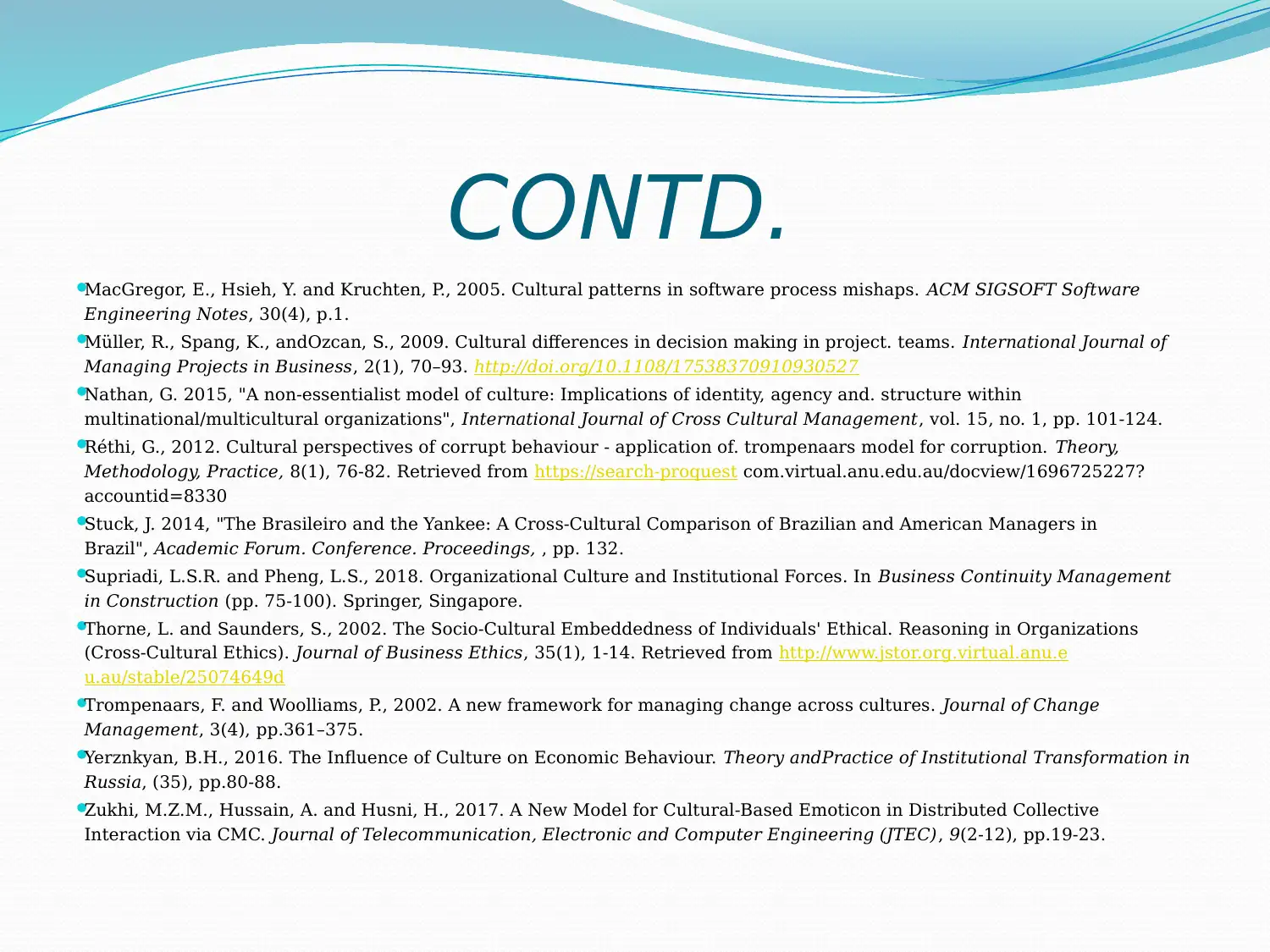
CONTD.
MacGregor, E., Hsieh, Y. and Kruchten, P., 2005. Cultural patterns in software process mishaps. ACM SIGSOFT Software
Engineering Notes, 30(4), p.1.
Müller, R., Spang, K., andOzcan, S., 2009. Cultural differences in decision making in project. teams. International Journal of
Managing Projects in Business, 2(1), 70–93. http://doi.org/10.1108/17538370910930527
Nathan, G. 2015, "A non-essentialist model of culture: Implications of identity, agency and. structure within
multinational/multicultural organizations", International Journal of Cross Cultural Management, vol. 15, no. 1, pp. 101-124.
Réthi, G., 2012. Cultural perspectives of corrupt behaviour - application of. trompenaars model for corruption. Theory,
Methodology, Practice, 8(1), 76-82. Retrieved from https://search-proquest com.virtual.anu.edu.au/docview/1696725227?
accountid=8330
Stuck, J. 2014, "The Brasileiro and the Yankee: A Cross-Cultural Comparison of Brazilian and American Managers in
Brazil", Academic Forum. Conference. Proceedings, , pp. 132.
Supriadi, L.S.R. and Pheng, L.S., 2018. Organizational Culture and Institutional Forces. In Business Continuity Management
in Construction (pp. 75-100). Springer, Singapore.
Thorne, L. and Saunders, S., 2002. The Socio-Cultural Embeddedness of Individuals' Ethical. Reasoning in Organizations
(Cross-Cultural Ethics). Journal of Business Ethics, 35(1), 1-14. Retrieved from http://www.jstor.org.virtual.anu.e
u.au/stable/25074649d
Trompenaars, F. and Woolliams, P., 2002. A new framework for managing change across cultures. Journal of Change
Management, 3(4), pp.361–375.
Yerznkyan, B.H., 2016. The Influence of Culture on Economic Behaviour. Theory andPractice of Institutional Transformation in
Russia, (35), pp.80-88.
Zukhi, M.Z.M., Hussain, A. and Husni, H., 2017. A New Model for Cultural-Based Emoticon in Distributed Collective
Interaction via CMC. Journal of Telecommunication, Electronic and Computer Engineering (JTEC), 9(2-12), pp.19-23.
MacGregor, E., Hsieh, Y. and Kruchten, P., 2005. Cultural patterns in software process mishaps. ACM SIGSOFT Software
Engineering Notes, 30(4), p.1.
Müller, R., Spang, K., andOzcan, S., 2009. Cultural differences in decision making in project. teams. International Journal of
Managing Projects in Business, 2(1), 70–93. http://doi.org/10.1108/17538370910930527
Nathan, G. 2015, "A non-essentialist model of culture: Implications of identity, agency and. structure within
multinational/multicultural organizations", International Journal of Cross Cultural Management, vol. 15, no. 1, pp. 101-124.
Réthi, G., 2012. Cultural perspectives of corrupt behaviour - application of. trompenaars model for corruption. Theory,
Methodology, Practice, 8(1), 76-82. Retrieved from https://search-proquest com.virtual.anu.edu.au/docview/1696725227?
accountid=8330
Stuck, J. 2014, "The Brasileiro and the Yankee: A Cross-Cultural Comparison of Brazilian and American Managers in
Brazil", Academic Forum. Conference. Proceedings, , pp. 132.
Supriadi, L.S.R. and Pheng, L.S., 2018. Organizational Culture and Institutional Forces. In Business Continuity Management
in Construction (pp. 75-100). Springer, Singapore.
Thorne, L. and Saunders, S., 2002. The Socio-Cultural Embeddedness of Individuals' Ethical. Reasoning in Organizations
(Cross-Cultural Ethics). Journal of Business Ethics, 35(1), 1-14. Retrieved from http://www.jstor.org.virtual.anu.e
u.au/stable/25074649d
Trompenaars, F. and Woolliams, P., 2002. A new framework for managing change across cultures. Journal of Change
Management, 3(4), pp.361–375.
Yerznkyan, B.H., 2016. The Influence of Culture on Economic Behaviour. Theory andPractice of Institutional Transformation in
Russia, (35), pp.80-88.
Zukhi, M.Z.M., Hussain, A. and Husni, H., 2017. A New Model for Cultural-Based Emoticon in Distributed Collective
Interaction via CMC. Journal of Telecommunication, Electronic and Computer Engineering (JTEC), 9(2-12), pp.19-23.
Paraphrase This Document
Need a fresh take? Get an instant paraphrase of this document with our AI Paraphraser

1 out of 14
Related Documents
Your All-in-One AI-Powered Toolkit for Academic Success.
+13062052269
info@desklib.com
Available 24*7 on WhatsApp / Email
![[object Object]](/_next/static/media/star-bottom.7253800d.svg)
Unlock your academic potential
© 2024 | Zucol Services PVT LTD | All rights reserved.




